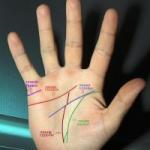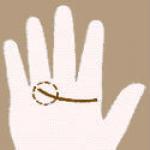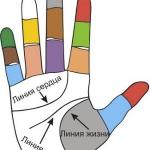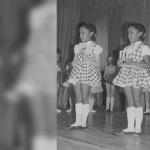Women's socks with knitting needles. Wandering stripes knitted socks
Materials:
80 grams of red and beige camel wool, 5 knitting needles # 2 and 2.5. On stocking needles No. 2 with red yarn, dial 64 loops for 42-44 sizes, and for 45-47 -74 loops. Distribute the loops evenly on 4 needles. Knit 6-8 cm with an elastic band 2 x 2 (2 persons, p. 2, p. 2). Next, on knitting needles No. 2.5, knit 2 circular rows with the front satin stitch with beige yarn and start knitting the strips, alternating 4 circular rows with beige yarn, 4 circular rows with red yarn, 2 rows with beige yarn. Then knit 2 rows of red and beige squares (2x2 loops), then again 2 rows of beige yarn and repeat the previous order of stripes in a mirror image.
Having knitted the second red strip after the row with "squares", proceed to knitting the heel using the "boomerang" method.
The boomerang heel is knitted on the loops of the 1st and 4th knitting needles, which must be divided into 3 parts. Set the loops of the 2nd and 3rd knitting needles aside.
First part of the heel:
1st row: (front row) knit all the loops of the faces. and turn the job.
2nd row: (purl row) start with a double loop: place the thread in front of work, insert the needle into the 1st st on the right, remove the loop and pull the thread back tightly (so that no holes are subsequently formed). The loop is scrolled on the spoke and becomes double. Place the thread again in front of work, knit the remaining loops out. and turn the job.
3rd row: at the beginning of the row, perform a double loop, then tie faces. p. to a double loop at the end of the row and turn the work. Do not knit a double loop!
4th row: at the beginning of the row, perform a double loop, then knit out. p. to a double loop at the end of the row and turn the work.
Then, on all the loops of the sock, tie 2 circular rows of faces. etc., knitting in the 1st row each double loop as 1 loop. Then put the loops of the upper part of the foot back.
Second part of the heel:
1st row: (front row): knit right and middle loops of faces. and turn the job.
2nd row: (purl row): perform a double loop, knit the remaining loops of the middle third. and turn the job.
3rd row: perform a double loop, tie faces. p. to a double loop, knit it as one loop of the faces., knit the 1st p. of the left third of the faces. and turn the job.
4th row: perform a double loop, tie in. p. to a double loop, knit it as one out loop, knit the 1st p. of the right third out. and turn the job.
After finishing the formation of the heel, knit again in a circle on the stocking needles all the loops of the sock to the end of the little finger.
To decrease the toe, divide the loops into 8 parts and knit the last 2 loops of each part together with the front loop, then repeat the decrease after 6 rows, after 5 rows, after 4 rows, after 3 and after 2 rows. Pull the remaining loops with a working thread, and fasten and hide the end.
Dimensions: 38-39 (40-41)
You will need: 100 g each of white, red, orange and gray wool blended yarn (200 m / 50 g); stocking needles No. 2.5; 2 red loops for the cord.
Front surface: persons. R. - persons. n., out. R. - out. p. In a circle. R. knit persons only. NS.
Purl surface: in circular rows knit only out. NS.
Elastic: alternately 2 persons., 2 out.
Openwork pattern A (at 29 p.): knit according to the pattern, in an even circle. R. all loops and yarns knit persons. Repeat the above loops and from the 1st to the 24th round. R., observing the alternation of colors.
Openwork pattern B: the number of loops is a multiple of 14: also knit according to the pattern, but repeat the rapport loops and from the 1st to the 24th round. R.
Sequence of stripes: 2 circle. R. * red, orange, white and gray thread, repeat from *.
Density of knitting, persons. smooth surface: 28 p. And 40 p. = 10 x 10 cm.
Basic course. Knitting socks with a 4-step method
STEP 1: toe. The buttonhole set is the same for all socks. For the toe, cast on 6 loops and, spreading over 3 knitting needles, close into a ring (Fig. 1), making sure that the bottom edges of all loops are directed downwards and the loops are not twisted. The end of the thread marks the beginning of the circular row. If necessary, it should be additionally marked with a thread of a contrasting color. When knitting, the mark moves up with the work and indicates where the circular row ends. Tie 1 circle. R. persons. p. (ill. 2). In the next circle. R. run from each loop 1 out. addition, knitting from 1 p. a total of 2 p.: 1 p. knit faces., then with the left knitting needle grab the link below the last knitted loop from back to front and knit faces. On these 12 sts, knit further persons. stitch, while in the next 2nd circle. R. execute from each 2nd p. 1 out. addition = 18 p. These p. are distributed as follows: 1st p. circle. R. forms the right middle point. The next 8 points form the upper part of the foot, the next point forms the left middle point and the remaining 8 points form the sole. To expand the toe in every 2nd circle. R. perform from the loop after both middle loops, 1 person. addition (ill. 3), knitting from 1 p. 2 p.: insert the right knitting needle into the next p. located below the circle. R. behind the loop from front to back and knit this loop of faces., while keeping the loop above it from the knitting needle. Then knit this loop of persons. Additionally, from the loop in front of both middle loops, perform 1 out. addition = 4 additions in each circle. R. Repeat these additions in every 2nd round. R. according to the table or instructions.
STEP 2: foot, heel and instep. Distribute the loops on 4 knitting needles as follows: loops from the right to left middle loops are evenly distributed on the 1st and 2nd knitting needles - they form the upper part of the foot, the remaining loops are evenly distributed on the 3rd and 4th knitting needles for the sole. For the foot, knit the length of the circle indicated in the table or instructions. R. or see Then for the rise in each next 2nd circle. R. from the loop after the right middle loop, perform 1 out. addition, from the loop in front of the left middle loop, perform 1 person. addition. Repeat these additions according to the table or instructions. Simultaneously with the 3rd addition for the rise, begin to perform the additions for the heel: from the loop after the left middle loop, perform 1 out. addition and from the loop in front of the right middle loop, perform 1 person. addition. Repeat these additions according to the table or instructions. The instep and heel extensions always end in the same circle. R.
STEP 3: heel cup. For the heel cup on the middle loops of the soles of the 3rd and 4th knitting needles, knit in straight and reverse rows, the number of loops is indicated in the table or instructions. There are heel loops on either side of the heel cup loops. Knit the loops of the upper part of the foot on the 1st and 2nd needles, as well as the right side loops of the heel and all the loops of the cup.
In this case, knit the last loop of the heel of the heel with the 1st left side loop of the heel together with a broach (Fig. 4): remove the 1st p. As faces., Knit the next p. Faces., Then insert the left knitting needle from left to right into the removed loop, stretch a knitted loop through it and lower it from the knitting needle. Turn the work and remove the 1st loop of the heel cup as wear .. while pulling the thread before work. Knit the remaining loops of the heel cups out, while knitting the last loop with the next right side loop of the heel together out. (ill. 5). thread, as in pur. p., is located in front of the left spoke. Insert a knitting needle from right to left through both loops, pull the thread and lower the loops from the left knitting needle. * Turn the work again and remove the 1st p. As persons., Thread at work. To knit the loops of the heel cups, knit the last loop with the next left side loop of the heel together with a broach. Turn the work again and remove the 1st loop of the cup as a wear. Pull the thread before work. To knit the loops of the cups out., While knitting the last loop with the next right side loop of the heel together, out. Repeat from * the number of times according to the table or instructions. Note: For most toe sizes, the upper foot loops can also be included in the heel cup.
STEP 4: pagolink. The boot starts at the end of the heel cup. In the 1st circle. R. knit the last loop of the cup with the next loop together with the broach. Knit the 1st loop of the cup with the previous loop together. (ill. 6), thread at work. Insert the right knitting needle from left to right through both loops, stretch the thread and lower the loops from the left knitting needle. As a result, the original number of loops is again reached. When the desired length of the leg is reached, all loops are free to close according to the pattern. Left toe: for socks with a side pattern on the heel, after the heel cup, distribute the heel loops symmetrically.
Right toe: for a toe with a white thread on stocking needles, dial 6 points and, according to the basic rate, perform additions up to 18 points. Knit faces. satin stitch. To expand on both sides of both middle stitches, add at the base rate in every 2nd circle. R. 10 x 4 p. = 58 p. Then knit as follows: knit the right middle loop. satin stitch in the sequence of stripes, on the next 28 p. knit with openwork pattern A, while to balance the pattern, add 1 p. = 29 p. openwork pattern, remaining n. knit persons. in the sequence of stripes = 59 sts in total. After 18 (19) cm from the typesetting edge, add for lifting at the base rate in each 2nd p. 8 (9) x 2 p. According to the figure. Between them, simultaneously with the 3rd addition for lifting, add for the heel in every 2nd p. 6 (7) x 2 p. Persons. smooth surface = 87 (91) p. Then, on the middle 18 (20) p. of the soles, perform the heel cup of the faces. satin stitch with white thread. At the same time, on both sides, knit the last and the first loops of the cup with the side loop of the sole together = 59 p. Then knit for the pagolenek on all loops with an openwork pattern, while in the 1st circle. R. knit the last loop of the cup with the next loop together with the broach, knit the first loop of the cup with the previous loop together. and additionally subtract to balance the pattern 1 p. = 56 p. After 36 circle. R. knit 1 circle for the strip with a white thread of an openwork pattern. R. persons. etc. and then knit with an elastic band. After 8 cm from the beginning of the strap for threading the cord, knit 2 persons. together persons. and make 1 yarn in return. These yarns are in the next circle. R. knit persons. Tie another 3.5 cm with an elastic band and close all loops loosely. Left toe: knit symmetrically.
Assembly: twist 2 cords 50 cm long from a double red thread, thread them into an openwork row and blocks and fasten with a double knot.
Cozy home knitted socks will give you warmth and comfort.
Socks size: 35/37 – 38/40 – 41/44
Foot length: 22 - 24 - 27 cm
Toe length: 33 - 36 - 39 cm
Material: Karisma superwash
100 g color No. 01, unpainted white
100 g color No. 44, light gray
100 g color No. 21, gray
Needles size 3.5 mm
Knitting density: 22 p. X 30 p. on needles 3.5 mm = 10 × 10 cm.
Elastic: repeat * 3 persons, 3 out *.
Pattern: See diagram.
Heel subtractions:
1 row (front side): Knit until 7-8-9 sts remain in a row, remove the next loop without tying, 1 person, stretch the knitted loop through the removed
2 row (wrong side): Knit until 7-8-9 sts remain, remove the next loop without tying, 1 out.
3rd row: Knit until 6-7-8 sts remain, remove the next loop without tying, 1 person, stretch the knitted loop through the removed
4th row: Knit until 6-7-8 stitches remain, remove the next loop without tying, 1 purl, stretch the knitted loop through the removed
5 row: Knit until 5-6-7 sts remain, remove the next loop without tying, 1 person, stretch the knitted loop through the removed
6 row: Knit until 5-6-7 stitches remain, remove the next loop without knitting, wear 1, stretch the knitted loop through the removed
Continue in this way, leaving 1 point less before each decrease until 10-10-10 points remain.
Sock: Cast on 66-72-78 sts on double-sided knitting needles with a thread of the color of undyed wool and knit with an elastic band and stripes according to the pattern. When knitting reaches 30-33-36 cm, subtract 1 point in each purl section, knitting 2 out together. p. purl (3 persons / 2 pins in elastic) = 55-60-65 p. When knitting reaches 32-35-38 cm, subtract 1 p. in each front section knitting together 2 front (2 front / 2 in elastic ) = 44-48-52 sts. When knitting reaches 33-36-39 cm (align after 6 rows with a thread of the color of undyed wool) place the average 22-24-26 sts on the auxiliary thread. Now knit 5-5.5-6 cm in stitch on the remaining 22-24-26 sts (= heel). Decreases for heel - see above. After the heel, cast on 11-13-15 sts on each side of the heel and place all loops on the needles = 54-60-66 sts. thread light gray and 2 rows with a gray thread and then continue according to the pattern. At the same time, decrease as follows: knit together 2 sts before the elastic and knit together 2 sts after the elastic for the back wall in every second row only 6 times = 42-48-54 sts. Continue until the length of the work reaches about 18- 20-22 cm from the heel. Align by repeating the pattern and finish the sock with a thread in the color of the undyed wool. Insert a marker on each side and subtract to thumb on both sides of each marker as follows: 2 persons. together in front of the marker and 2 out. together after the marker behind the back wall. Repeat the decrease in every second row only 3 times = 30-36-42 p. Then decrease in each row only 6-7-9 times = 6-8-6 p. Will remain. Cut off the thread and thread it through the remaining loops. Sew.
Designations on the diagram:
Empty square = unpainted white
Squared bar = light gray
Black square = gray
Socks size: 35/37 – 38/40 – 41/44
Foot length: 22 - 24 - 27 cm
Toe length: 33 - 36 - 39 cm
Materials: Karisma superwash
100 g color No. 01, unpainted white
100 g color No. 44, light gray
100 g color No. 21, gray
Needles size 3.5 mm
Knitting density: 22 p. X 30 p. on needles 3.5 mm = 10 × 10 cm.
Elastic band: repeat * 3 persons, 3 out *.
Pattern: See diagram.

Designations on the diagram:
Empty square = unpainted white
Squared bar = light gray
Black square = gray
Heel subtractions:
1 row (front side): Knit until 7-8-9 sts remain in a row, remove the next loop without tying, 1 person, stretch the knitted loop through the removed
2 row (wrong side): Knit until 7-8-9 sts remain, remove the next loop without tying, 1 out.
3 row: Knit until 6-7-8 sts remain, remove the next loop without tying, 1 person, stretch the knitted loop through the removed
4th row: Knit until 6-7-8 stitches remain, remove the next loop without tying, 1 purl, stretch the knitted loop through the removed
5 row: Knit until 5-6-7 sts remain, remove the next loop without tying, 1 person, stretch the knitted loop through the removed
6 row: Knit until 5-6-7 stitches remain, remove the next loop without knitting, wear 1, stretch the knitted loop through the removed
Continue in this way, leaving 1 point less before each decrease until 10-10-10 points remain.
Sock: Cast on 66-72-78 sts on double-sided knitting needles with a thread of the color of undyed wool and knit with an elastic band and stripes according to the pattern. When knitting reaches 30-33-36 cm, subtract 1 point in each purl section, knitting 2 out together. p. purl (3 persons / 2 pins in elastic) = 55-60-65 p. When knitting reaches 32-35-38 cm, subtract 1 p. in each front section knitting together 2 front (2 front / 2 in elastic ) = 44-48-52 sts. When knitting reaches 33-36-39 cm (align after 6 rows with a thread of the color of undyed wool) place the average 22-24-26 sts on the auxiliary thread. Now knit 5-5.5-6 cm in stitch on the remaining 22-24-26 sts (= heel). Decreases for heel - see above. After the heel, cast on 11-13-15 sts on each side of the heel and place all loops on the needles = 54-60-66 sts. with a light gray thread and 2 rows with a gray thread and then continue according to the scheme. At the same time, decrease as follows: knit together 2 sts before the elastic and knit together 2 sts after the elastic for the back wall in every second row only 6 times = 42-48-54 sts. Continue until the length of the work reaches about 18- 20-22 cm from the heel. Align by repeating the pattern and finish the sock with a thread in the color of the undyed wool. Insert a marker on each side and subtract for the thumb on both sides of each marker as follows: Face 2. together in front of the marker and 2 out. together after the marker behind the back wall. Repeat the decrease in every second row a total of 3 times = 30-36-42 p. Then decrease in each row only 6-7-9 times = 6-8-6 p. Will remain. Cut the thread and thread it through the remaining loops. Sew.
a specially for siteIn contact with
classmates

Today I will tell you about how to tie simple, but at the same time very beautiful socks for all family members... For a beautiful mother (do not even doubt, all mothers are beautiful, the children are sure of this, and the truth is spoken through the lips of a child), for the daughter of a little fashionista, for a strong dad and an athletic son. The main presented model of socks is not at all difficult to knit, it is quite within the power of beginners.
Number of loops (knitting density).
My mother-in-law taught me to knit, for which I am very grateful to her. So, the first thing she taught me was to quantify required loops... Everything is elementary. It is necessary to dial a certain number of loops and knit with the main knitted rows 7-10. We will get a rectangle, which we will measure and compose the ratio.
For example, 12 loops typed and knitted - it turned out 5 s m.

From here we will dance. We should take two measurements: the circumference of the leg at the bone and along the instep (see the picture below). Knowing these dimensions, we determine the average circumference of the leg. To do this, add both measurements and divide the result by two. So, for example, the 1st measure is 23 cm, the 2nd measure is 27 cm. Therefore, 23 cm + 27 cm = 50 cm; 50 cm: 2 = 25 cm.

Thus, in our example, we calculate the number of loops at 25 cm. 12 loops - 5 cm x loops - 25 cm Remembering math and getting 60 loops. This is the basis that will help us when knitting any thing.
Knitting technique for socks
Let's explore the knitting technique for classic socks. According to this principle, we can knit socks for all family members... We knit socks on five needles. The number of loops in the set is a multiple of four. Depending on the density and quality of the thread, one pair is consumed from 70

We begin to knit the sock from the cuff. Most often we use knitting elastic band 1 x 1(1st row - 1 front, 1 purl, 2nd row and all subsequent ones as well - front loops with front, purl - purl) or 2 x 2(1st row - 2 front, 2 purl, the second and subsequent ones are the same, also note that we knit the front loops with the front, purl - with the purl).


Top of the sock.
Our loops need to be distributed over 4 knitting needles, closed in a ring and knitted with an elastic band. The length of the top of the sock can be from 5 to 12 cm, on average, according to your taste. The transition from one row to another occurs along the back line of the middle.


Heel back
The next stage - after you have tied the elastic of the sock to the desired height, we separate exactly half of all the loops and start working with them. We knit a straight fabric, this will be the back of the heel. Please note: we knit 1 row with the front, 1 row with the purl, then again 1 row with the front, 1 p. purl and so on until the height of the knitted fabric is about 10 cm.

This is what our sock looks like from the back.

Then the mathematical part begins. We count how many loops we have on the straight part. (for example, I'm 24). We divide this amount into three parts as follows - the middle part is slightly larger, the other two are equal to each other and slightly less than the average. (in our example 24 = 7 + 10 + 7).
We knit like this: 1. We knit the first third of the loops (7) without any tricks. Following it, we immediately knit further the middle part (10) to the penultimate loop, (in example 9). We knit the last loop of the middle part together with the first loop of the third part. We turn the work.

We knit only the middle part (10 loops). As soon as the 9th loop has been knitted, we repeat our action: we knit the 10th loop together with the first loop of the side part.

We turn the work. We repeat steps 1 and 2 to the end. We make sure that there are always 10 loops in the middle part. The side sections will “fall off” as you knit the stitches together.

Your goal is not to leave a single loop on the spoke from the side pieces. Here's what you should get.

We look at what we get as a result of tying the heel.
 master class). ">
master class). ">
Foot lift, foot length.
The next step is to knit a wedge that will form the rise of the toe. We type on the edge loops (shown in red) of the sidewalls of the heel of the loop, pull out one loop from each edge knitting needle. Then we knit loops from the knitting needles, which we had "non-working". When knitting reaches the second side of the heel, we collect again from the edge loops. 1 hem = 1 loop. We knit further on 4 knitting needles 3-4 rows without changes.

Now we need to reduce the number of stitches on the needles. We do it this way: we knit two front loops at the beginning and at the end of the side wedge, that is, on 2 and 4 knitting needles. The figure clearly shows the decrease in the canvas.

We do this 2-3 times, as a result we get a neat wedge. Next, knit to the length of the foot evenly in a circle.

Toe
At the end, you need to tie the toe. To neatly and evenly finish the sock, we decrease the loops in the following order: Divide all the loops that we have on the knitting needles in half. Let's say we have 48 of them, so it will be 24 in half. We calculate the first decrease: we knit 1 loop, knit 2 and 3 together, from 4 to 21 knit front, 22 and 23 together, 24 and 25 front, 26 and 27 together, with 28 to 45 front, 46 and 47 together, 48 front. In the next rows we knit two together before and after the track of the two front ones.

Two last loops knit together, in one remaining thread, and tighten. Crochet the thread inside the sock.
With this technology, you can knit socks for all family members... Make calculations, turn on your imagination and go! To begin with, you can knit plain socks, then knit socks from yarn consisting of threads different colors, with original texture. When the technology is easy for you, you can start patterns, alternate threads (several rows with one thread, then tie a thread of a different color and knit, etc.). Here are some socks for the whole family:




 master class). ">
master class). ">



If you have experience and want something more complicated, please:
FOR BEAUTIFUL MOM COCKETLY SOCKS

Size 38/39
Would need: 50 g of Regia Silk Color yarn (color 184; 55 ° / o wool, 20% silk, 25% polyamide, 200 m / 50 g), 50 g white Brazilia (100 ° / o polyamide, 90m / 50 g), knitting needles.
Elastic: knit alternately 1 front, 1 purl. Front surface: persons. R. - persons. n., out. R. - out. etc., in circular rows, knit all loops of persons.
Density of knitting, persons. smooth surface, thread Regia Silk: 30 p. And 42 circular p. = 10 x 10 cm.
Work description: With Regia Silk Color thread, cast on 60 sts. For curling edge, tie 5 circular p. persons. satin stitch. Then knit with Brazilia thread 3 cm with elastic and Regia Silk thread for 2 cm faces. satin stitch. Then knit the heel and foot according to the general rules for knitting socks.
note: start knitting both socks with the same color rapport of the yarn, while pulling the thread from the outside of the ball.
FOR FASHION WOMAN'S DAUGHTER

Size 32/33
Would need: 100 g of multi-colored Regia Color jacquard yarn in 6 strands (75% wool, 25% polyamide, 125 m / 50 g). Knitting needles, hook.
Front surface:
Fringe: fasten the thread and tie 1 air. p., * 1 tbsp. 6 / n, 9 air. p., then in the 2nd and in each next air item. link 2 with. b / n, 1 p. skip, 1 tbsp. b / n, repeat from *. Finish the circular row with 1 connection. Art. in the 1st st. 6 / n.
Knitting density: 22 p. And 30 p. - 10 x 10 cm. Work description: dial 44 sts and tie 12 cm of faces. satin stitch, then perform the boomerang heel and foot according to the general rules for knitting socks. Tie a fringe along the inlaid edge, turn the edge 1 cm to the front side.
FOR SPORTS SON Size 38/39

Would need: 50 g each of white and black Regia Stretch yarn (70% wool, 23% polyamide, 7% polyester, 200 m / 50 g), 50 g raspberry Regia in 4 strands (75% wool, 25% polyamide l, 210 m / 50 g) ), knitting needles, hook.
Front surface: persons. R. - persons. n., out. R. - out. NS.; in circular rows, knit all loops of persons.
Two-color patent pattern: even number of loops. 1st circular p., Black thread: persons p. 2nd circular p., White thread: out. p. 3rd circular p., black thread: * 1 out., 1 p. in the puncture (1 person., while inserting a needle 1 p. lower), repeat from *. After 1 hectare circular river. repeat 2nd and 3rd circular p.
Density of knitting. persons. smooth surface: 30 p. And 42 p. = 10 x 10 cm. Work description: with a raspberry thread, dial 60 sts and knit 3 circular p. persons. satin stitch. Then tie 15 circular p. = 2.5 cm two-color patent pattern, 1 circular p. faces, black thread, then tie the faces. satin stitch 2 circular p. crimson, then with a white thread perform a boomerang heel according to the general rules for knitting socks. After that, knit alternately 6 p. black, 2 p. raspberry. After 20 cm from the beginning of the foot, perform a toe with a white thread. Behind in the middle, tie a loop of 10 air with a thread in 2 additions. NS.
FOR A STRONG DAD

Size 38/39
Would need: 100 g of Regia Color jacquard yarn in 4 strands (75% wool, 25% polyamide, 210 m / 50 g), 50 g gray melange yarn Regia in 4 strands (75% wool, 25% polyamide. 210 m / 50 g), knitting needles, 2 cord locks.
Faced the smooth surface: persons. R. - persons. n., out. R. - out. p.: in circular rows, knit all loops of persons.
Elastic: alternately 2 persons .. 2 out.
Density of knitting, persons. smooth surface: 30 p. And 42 p. = 10 x 10 cm.
Work description: for the right toe, dial 60 stitches with gray thread and knit for a double plank of faces. satin stitch. Knit 12 circular p., Then knit the loops of the 1st knitting needles for the cut, knit between the 1st and 2nd knitting needles in straight and reverse rows, then knit again in circular rows. Through 18 circular rivers. (= 4.5 cm) knit each stitch on the knitting needle and the stitch of the inlaid edge together. Next knit persons. satin stitch jacquard thread, while in the 1st circular p. add 12 points evenly (= 72 points).
After 12 cm from the plank, reduce the added 12 points evenly and continue working with a gray thread. Knit 1 circular p. persons. stitch, 10 circular p. with an elastic band and another 1 cm of faces. satin stitch, after which he will perform the boomerang heel and foot according to the general rules for knitting socks. Knit the left sock asymmetrically, that is, make a cut in the double plank between the 3rd and 4th needles. From a gray thread, weave 2 cords 40 cm long and stretch them with a pin through the double slats, the ends of the cords are threaded through the clips.





